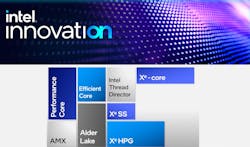Click here to see the rest of our Intel Innovation 2021 coverage including the keynote video
Intel Innovation is the first event in the new Intel ON series. It marks the return of CEO Pat Gelsinger and Intel's developer conference that used to be called the Intel Developers Forum (IDF). This year's event was virtual, so you can still log in and check out the presentations.
In his keynote presentation, Mr. Gelsinger presented a number of technology announcements and partnerships.
At the top of the list is Intel's 12th-generation "Alder Lake" desktop CPU. The high-end, unlocked models of the Core i9 series combine eight performance cores with eight efficiency cores that provide a 50% performance bump compared to its earlier sibling. The Core i9-12900K has a peak power of 241 W.
Other platforms in the mix include the Arc discrete GPU code named "Alchemist." It incorporates 32 Xe cores. Each Xe core has 16 vector processing engines and 16 matrix engines for a total of 512 execution units per chip. The chip communication supports Intel's Deep Link technology. These GPUs are well-suited for the desktop and gaming.
Intel's Developer Zone and GameDev Program target these new CPU and GPU platforms. The Developer Zone is also home to the Intel oneAPI and OpenVINO deep-learning toolkit.
The company's intelligent fabric targets the cloud and enterprise servers that will utilize the Tofino 3 Intelligent Fabric Processor (IFP) and the "Mount Evans" Infrastructure Processing Unit (IPU). Google Cloud is a co-developer of the IPU. For more conventional servers, there are the next-gen Xeon processors, code-named Sapphire Rapids, but they're not due till 2022.
Partnership mentions include one with European chipmaker SiPearl. SiPearl will use the upcoming Ponte Vecchio GPU for the European supercomputer. It will also use Intel’s oneAPI toolkits to program the system. The oneAPI AI Analytic toolkit also ties together a set of data science platforms with OEMs like HP, Dell, and Lenovo. The platform is based on Ubuntu.
Amazon Web Services (AWS) launched EC2 DL1 instances that utilize the Habana Gaudi chips. Intel acquired Habana in 2019. The Gaudi chips will be used for neural-network training in the cloud. It delivers a 40% price-performance improvement compared to GPGPUs performing the same task.
Intel pledged that it will achieve zettascale computing by 2027. Mr. Gelsinger said, “Today we are predicting that we will maintain or even go faster than Moore‘s Law for the next decade.” We shall see what 2022 brings first.
Links:
About the Author
William G. Wong
Senior Content Director - Electronic Design and Microwaves & RF
I am Editor of Electronic Design focusing on embedded, software, and systems. As Senior Content Director, I also manage Microwaves & RF and I work with a great team of editors to provide engineers, programmers, developers and technical managers with interesting and useful articles and videos on a regular basis. Check out our free newsletters to see the latest content.
You can send press releases for new products for possible coverage on the website. I am also interested in receiving contributed articles for publishing on our website. Use our template and send to me along with a signed release form.
Check out my blog, AltEmbedded on Electronic Design, as well as his latest articles on this site that are listed below.
You can visit my social media via these links:
- AltEmbedded on Electronic Design
- Bill Wong on Facebook
- @AltEmbedded on Twitter
- Bill Wong on LinkedIn
I earned a Bachelor of Electrical Engineering at the Georgia Institute of Technology and a Masters in Computer Science from Rutgers University. I still do a bit of programming using everything from C and C++ to Rust and Ada/SPARK. I do a bit of PHP programming for Drupal websites. I have posted a few Drupal modules.
I still get a hand on software and electronic hardware. Some of this can be found on our Kit Close-Up video series. You can also see me on many of our TechXchange Talk videos. I am interested in a range of projects from robotics to artificial intelligence.

